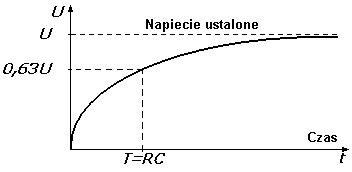Hello!
See the drawing:

If from a source (e.g. a battery) with a voltage U, a current flows through the resistor R to the DISCHARGE capacitor C, then the voltage on its electrodes will start to rise according to the diagram in the figure.
The rate of voltage rise depends both on the resistance of the resistor R and the capacitance of the capacitor C. The product R * C is called the time constant, and the special property of this time constant is such that after the time T = RC on the capacitor there will be 63% of the steady voltage U, to which the capacitor will be charged after the INFINITELY time, but in practice we assume that it will be after a time equal to a few time constant (after a time equal to 10 time constant, the difference is only 0.0005%).



